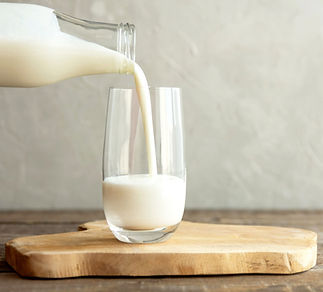
Why the Milk Matters
“We don’t just care about taste—we care about how it makes you feel.”
A priority for us at Frankie’s is providing people with useful information, along with a delicious pint. We don’t want you to buy our ice cream only because its phenomenal and the packaging is super aesthetic. We want Frankie’s to be your go to because you understand its benefits.
The Dairy Story is long and we cover it all here. If your in a crunch, here's a summary:
-
Skim Milk is a scam which aims to improve margins at the expense of your health. Whole milk contains the proper fat content needed to absorb nutrients from milk.
-
Not all whole milk is created equally, that's why we opt for low-temp pasteurized A2 to preserve nutrients, improve digestion, and promote a richer, creamier flavor.
We Take Dairy Personally
We feel super passionate about dairy here, obviously. And because ice cream is (or at least should be) a predominantly dairy product, we weren’t going to mess around when it came to quality.
When you buy a pint of ice cream off the shelves of the grocery store, the ingredient label is going to have some sort of dairy component. (If it doesn’t, I’m gonna hold your hand when I say this: it’s not ice cream.)
The Skim Milk Scam
The dairy used in a majority of name brand ice cream companies is skim milk—regular cow’s milk with nearly all the fat removed. Yeah, we get the appeal. Something labeled “low fat” sounds healthier, right? But those ingredient labels don’t come with a nutrition lesson.
Fat-soluble vitamins need fat to work—so when you take out the fat, you take out the function. You’re left with sugar water and synthetically added vitamins pretending to do the job nature already handled just fine.
So why do companies use skim milk if it has virtually no nutritional value? We were wondering the same thing. For starters, it’s cheaper. Less cream = more margin. Removing the fat gives brands room to pump in more sugar, gums, and stabilizers while still slapping a “low-fat” label on the front. Those additives might extend shelf life, but they do nothing good for your digestive system.
It’s Not Milk’s Fault. It’s What We Did to It.
For those companies who get the whole milk concept, they’re still not choosing quality over quantity. Most conventional dairy comes from high-yield cows bred for volume, not quality. Many people experience bloating, discomfort, or inflammation—not because of milk itself, but because of how it’s been altered. Add in hormones, antibiotics, and feedlot diets, and it’s no wonder conventional dairy doesn’t sit right. But it didn’t always used to be this way.
Let’s Start with the Basics
“Not all milk proteins are created equal.”
Milk contains a protein called beta-casein, and there are two main types: A1 and A2.
When A1 is digested, it can produce a peptide called BCM-7, which some studies link to gut inflammation, discomfort, and other issues. A2 beta-casein does NOT produce BCM-7 and is often better tolerated. A2 is also found naturally in human, goat, and sheep milk.
Where A2 Went (and Why We’re Bringing It Back)
Originally, all cows produced only the A2 beta-casein protein. But over time, due to a natural genetic mutation in European dairy cows (especially Holsteins, which are now the most common breed used in large-scale dairy production), many cows began producing both A1 and A2 proteins.
Farmers bred for traits like higher milk yield, not casein type—so A1/A2 became the norm without anyone realizing it had changed the milk's digestibility for some people. A2 got replaced over time simply because no one was paying attention to it. They were just breeding for more milk, not better milk.
Pasteurization: The Final Blow
“If it couldn’t get worse...”
This low quality, nutritionally empty, synthetically altered dairy that’s used in ice cream also goes through a process called pasteurization.
Pasteurization is the process of heating milk to kill harmful bacteria and extend shelf life. The most common method in the U.S. is high-temperature, short-time (HTST) pasteurization—though some milk is ultra-pasteurized.
What does pasteurization do? We’re told it's to “kill harmful bacteria” which means it's safe and good for us, right?
What we aren’t told is that it also:
-
Kills beneficial enzymes that aid digestion (like lactase and lipase)
-
Reduces heat-sensitive nutrients
-
Alters proteins (if any are left) which can make the milk harder to digest for some people
What We Do Instead
At Frankie’s, the dairy we use is low-temp (vat) pasteurized. Low-temp pasteurization gently heats the milk to preserve more nutrients, keep natural enzymes intact, support easier digestion, and deliver a richer, creamier flavor—closer to how milk was meant to be.
But maybe we’re wrong. Maybe conventional dairy isn’t so bad...
Let’s Visualize It Together
-
You start with dairy that already contains proteins linked to dairy intolerance.
-
You remove the fat content, which also removes any beneficial proteins the milk had.
-
You synthetically add these proteins back in along with sugar, gums, stabilizers and whatever else you need to make the ice cream look and somewhat taste real.
-
And then you light the mixture up to a temperature so hot that it “kills” any bad bacteria that’s somehow worse than the toxins and carcinogenics you added in voluntarily.
Gross.
Real Ice Cream is Back
At Frankie’s we’re just making ice cream the way it was supposed to be enjoyed.
-
Minimal ingredients
-
Digestible dairy
-
Real flavors
-
A sweetness that’s unrefined yet rich enough to keep you coming back for more.
Real ice cream is back—you can tell your gut it’s safe now.
